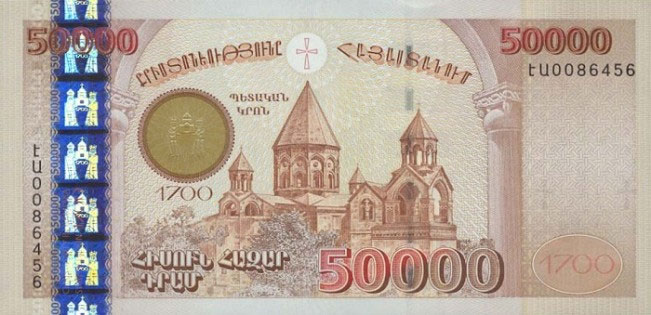After the second independence, the Central Bank of Armenia was created on March 27, 1993. The new Armenian monetary unit was called dram (դրամ); the name, which means “money” in Armenian, was also the name of the silver coins in circulation during the Armenian kingdom of Cilicia (1199-1375). Interestingly, the word դրամ, pronounced tram, designates “money” in Western Armenian; Eastern Armenian uses the word փող (pogh) to designate “money.” Pogh was also the name of a certain type of copper coins in the Armenian state of Cilicia.
The devaluation of the Russian ruble (which initially continued as the currency in the former Soviet Union following the collapse of the state) prompted the replacement of old currency by new one, and a flood of worthless old Russian rubles into Armenian forced the introduction of the dram, earlier than anticipated, on November 22, 1993. The initial value was 1 dram = 200 Russian rubles, while 1 American dollar equaled 14 drams. The high inflation of the period 1993-1994 in Armenia depreciated the dram to a value of 1 U$S = 100 AMD. It reached 420 drams per dollar in March 1995 and stabilized afterwards (450 AMD per dollar in 1997). On November 19, 2012, the exchange rate was 407 dram per American dollar.
The banknotes issued in 1993-1995 were put out of circulation in 2005. Their value went from 10 to 5,000 drams. This old series, which today only has a historical value, featured different national symbols: for instance, the 10 dram note showed the Yerevan Central Train Station and the statue of David of Sassoun (across the station) on the obverse and Mount Ararat on the reverse, while the 5000 dram note exhibited the pagan temple of Garni on the obverse and the head of goddess Anahit kept in the British Museum on the reverse.
A new
series of banknotes, currently in circulation, was issued starting in
1998. The first six values, from 50 to 20,000 drams (the notes of 50,
100, and 500 were later put out of circulation and replaced by coins),
featured six figures of twentieth century Armenian culture and an image
related to them: Aram Khachaturian, Victor Hambardzumian, Alexander
Tamanian, Yeghishe Charents, Hovhannes Tumanian, and Avetik Isahakian.
The 50,000 dram banknote was issued in 2001, on the 1700th anniversary
of Christianity in Armenia, and featured the cathedral of Holy
Etchmiadzin. The highest value, 100,000 dram, pictured King Abgar V of
Edessa, who according to tradition received the painting (portrayed
alive) of Jesus Christ from St. Thaddeus


